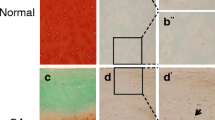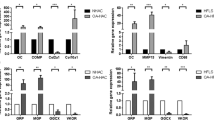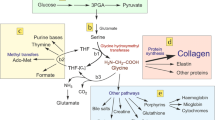Abstract
Abnormal metabolism of extracellular inorganic pyrophosphate (PPi) by articular cartilage contributes to calcium pyrophosphate dihydrate (CPPD) crystal formation and the resultant arthritis known as CPPD deposition disease. The factors causing excess PPi elaboration in affected cartilage remain poorly defined. Retinoic acid (RA), a naturally occurring vitamin A metabolite, promotes cartilage degeneration and mineralization, two correlates of CPPD crystal deposition. RA was examined as a potential modifier of cartilage PPi elaboration. All-trans RA (200–1000 nM) increased PPi levels in culture medium of normal porcine cartilage and chondrocytes 2–3-fold over control values at 96 hours of incubation (P < 0.01). IGF1 and anti-EGF antibody diminished the effects of RA on PPi elaboration. RA modestly increased activity of the PPi-generating ectoenzyme NTPPPH in culture medium (P < 0.01). As some RA effects are mediated through increased activity of TGF\, a known PPi stimulant, we examined the effect of anti-TGF\ antibody on RA-induced PPi elaboration. PPi levels in medium were reduced from 30 ± 7 fxM in cartilage cultures with 500 nM RA to 14 ± 4 ΜM PPi in cartilage cultures with RA and anti-TGF\. Anti-TGF\ antibody, however, had no significant effect on RA-induced PPi elaboration in chondrocyte cultures. Thus, RA, along with TGF\ and ascorbate, can now be included in the list of known PPi stimulants. All three of these factors promote mineralization in growth plate cartilage. These data support a central role for TGF\ in CPPD disease, and provide further evidence linking processes of normal and pathologic calcification in cartilage.
Similar content being viewed by others
References
Doherty M, Dieppe P (1988) Clinical aspects of calcium pyrophosphate dihydrate crystal deposition. Rheum Dis Clin N Am 14:305–414
McCarty DJ, Hogan JM, Gatter RA (1966) Studies on pathologic calcification in human cartilage. J Bone Jt Surg [Am] 48:309–414
Felson DT, Anderson JJ, Naimark A, Kannel W, Meenan RF (1989) The prevalence of chondrocalcinosis in the elderly and its association with knee osteoarthritis: the Framingham study. J Rheumatol 16:1241–1245
Silcox DC, McCarty DJ (1974) Elevated inorganic pyrophosphate concentration in synovial fluid in osteoarthritis and pseudogout. J Lab Clin Med 83:518–531
Altman RD, Muniz, O, Pita JC (1973) Articular chondrocalcinosis: microanalysis of pyrophosphate in synovial fluid and plasma. Arthritis Rheum 16:171–178
Ryan LM, Cheung HS, McCarty DJ (1981) Release of pyrophosphate by normal mammalian articular and fibro-cartilage in organ culture. Arthritis Rheum 24:1522–1527
Rosenthal AK, Cheung HS, Ryan LM (1991) Transforming growth factor \l stimulates inorganic pyrophosphate elaboration by porcine cartilage. Arthritis Rheum 34:904–910
Olmez U, Ryan LM, Kurup I, Rosenthal AK (1994) IGF1 suppresses TGF\-induced pyrophosphate elaboration by cartilage. Osteoarthritis Cartilage 2:149–154
Derfus BA, Rachow JW, Mandel NS, Boskey AL, Buday M, Kushnaryov VM, Ryan LM (1992) Articular cartilage vesicles generate calcium pyrophosphate crystals in vitro. Arthritis Rheum 35:231–240
Limoni RP, Escarcena C, Schmid TM, Davies S, Derfus BA (1995) Type X collagen is associated with mineralizing matrix vesciles isolated from osteoarthritic human cartilage (abstract) Trans Orth Res Soc 20:33–36
Morales TI, Roberts AB (1992) The interaction between retinoic acid and the transforming growth factors-\ in calf articular cartilage organ cultures. Arch Biochem Biophys 293: 79–84
Von den Hoff HW, de Koning MHMT, van Kampen GPJ, vander Korst JK (1994) Transforming growth factor-\ stimulates retinoic acid-induced proteoglycan depletion in intact articular cartilage. Arch Biochem Biophy 313:241–247
Iwamoto M, Shapiro IM, Yagami K, Boskey AL, Leboy PS, Adams SL, Pacifici M (1993) Retinoic acid induces rapid mineralization and expression of mineralization-related genes in chondrocytes. Exp Cell Res 207:413–420
Morales TI, Joyce ME, Sobel ME, Danielpour D, Roberts, AB (1991) Transforming growth factor-beta in calf articular cartilage organ cultures: synthesis and distribution. Arch Biochem Biophys 288:397–405
Kinoshita A, Takigawa M, Suzuki F (1992) Demonstration of receptors for epidermal growth factor on cultured rabbit chondrocytes and regulation of their expression by various growth and differentiation factors. Biochem Biophys Res Comm 183: 14–20
Mitchell PG, Cheung HS (1992) Tumor necrosis factor alpha and epidermal growth factor regulation of collagenase and stromelysin in adult porcine articular chondrocytes. J Cell Phys 149:132–140
Lowry OH, Rosebrough NJ, Farr AL, Randall RJ (1951) Protein measurement with the Folin phenol reagent. J Biol Chem 193:265–272
Chueng CP, Suhadolnik RJ (1964) Analysis of inorganic pyrophosphate at the picomole level. Anal Biochem 83:61–63
Sugino Y, Miyoshi Y (1964) The specific precipitation of orthophosphate and some biochemical applications. J Biol Chem 239:2360–2364
Rachow JW, Ryan LM, McCarty DJ, Halverson PC (1988) Synovial fluid inorganic pyrophosphate concentration and nucleotide pyrophosphorylase activity in basic calcium phosphate arthropathy and Milwaukee Shoulder Syndrome. Arthritis Rheum 31:408–413
Satre MA, and Kochhar DM (1989) Elevations in the endogenous levels of the putative morphogen retinoic acid in embryonic mouse limb-buds associated with limb dysmorphogenesis. Dev Biol 133:529–536
Nesher G, Zuckner J (1995) Rheumatologic complications of vitamin A and retinoids. Semin Arthritis Rheum 24:291–296
Villiger PM, Terkeltaub R, Lotz M (1992) Monocyte chemoattractant protein-1 (MCP-1) expression in human articulaicartilage. J Clin Invest 90:488–496
Cancela ML, Price PA (1992) Retinoic acid induces matrix gla protein gene expression in human cells. Endocrinology 130:102–108
Pacifi M, Golden EB, Iwamoto M, Adams SL (1991) Retinoic acid treatment induced type X collagen gene expression in cultured chick chondrocytes. Exp Cell Res 195:38–46
Ryan LM, Kurup I, Cheung HS (1991) Stimulation of cartilage inorganic pyrophosphate by ascorbate. Matrix 11:276–281
Gerstenfeld LC, Landis WJ (1991) Gene expression and extracellular matrix ultrastructure of a mineralizing chondrocyte cell culture system. J Cell Biol 112:501–513
O’Keefe RJ, Puzas E, Brand JS, Rosier RN (1988) Effect of transforming growth factor-\ on DNA synthesis by growth plate chondrocytes: modulation by factors present in serum. Calcif Tissue Int 43:352–358
Hall K, Sara VR (1984) Somatomedin levels in childhood, adolescence, and adult life. J Clin Endocrinol Metab 134:91–112
Tong PS, Horowitz NN, Wheeler LA (1990) Trans retinoic acid enhances the growth response of epidermal keratinocytes to epidermal growth factors and transforming growth factor beta. J Invest Dermatol 94:126–131
Author information
Authors and Affiliations
Rights and permissions
About this article
Cite this article
Rosenthal, A.K., Henry, L.A. Retinoic acid stimulates pyrophosphate elaboration by cartilage and chondrocytes. Calcif Tissue Int 59, 128–133 (1996). https://doi.org/10.1007/s002239900099
Received:
Accepted:
Issue Date:
DOI: https://doi.org/10.1007/s002239900099




